六年级英语考试常见知识点总结图文稿
详细PEP新人教版小学英语六年级下册知识点归纳总结(高效记忆)课件

I wear size 7 shoes. 我穿7码的鞋。
句型
比较级,用来对自己和 他人的身体特征进行比较
I'm thinner than you. 我比你瘦。
My hands are bigger than yours. 我的手比你的手大。
Your feet are bigger than mine. 你的脚比我的脚大。
badminton 羽毛球运动
cycling 骑自行车运动
go cycling 骑自行车
原形→过去式。
be 动 词
am/ is→ was
are→were
feel→felt感觉
think→thought认为,想
wake→woke 醒来
Unit 4 Then and now
句型—
表示以前 没有某物
过去不能做或 者不会做某事
PEP人教版六年级下册
Unit 2 Last Weekend
思维导图记忆法
Unit 2 Last Weekend
clean my room 打扫我的房间
clean→cleaned 打扫
watched TV 看电视
watch→ watched 看
stayed at home 待在家里
stay→stayed 待在
There was no+单数名词/不可数名词+过去时间 chool.
There was no library in my old s 在我以前的学校里没有图书馆 。
There were no+复数名词+过去时间
time.
在我那时候没有电脑有没有网络。 There were no computers or Internet in my
PEP人教版 六年级英语 上册第一学期秋(期中期末考试总复习 单元知识梳理)Unit 6 单元知识小结(图表式)
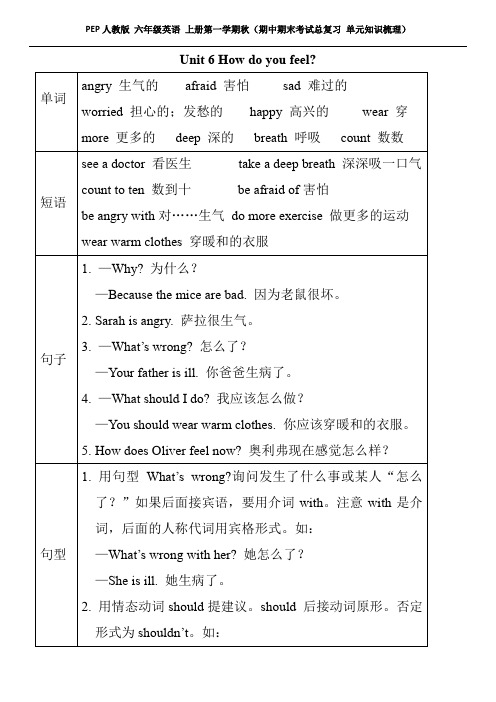
4. —What should I do?我应该怎么做?
—You should wear warm clothes.你应该穿暖和的衣服。
5. How does Oliver feel now?奥利弗现在感觉怎么样?
句型
1.用句型What’s wrong?询问发生了什么事或某人“怎么了?”如果后面接宾语,要用介词with。注意with是介词,后面的人称代词用宾格形式。如:
be angry with对……生气do more exercise做更多的运动
wear warm clothes穿暖和的衣服
句子
1.—Why?为什么?
—Because the mice are bad.因为老鼠很坏。
2. Sarah is angry.萨拉很生气。
3. —What’s wrong?怎么了?
Unit 6 How do you feel?
单词
angry生气的afraid害怕sad难过的
worried担心的;发愁的happy高兴的wear穿
more更多的deep深的breath呼吸count数数
短语
see a doctor看医生take a deep breath深深吸一口气
count to ten数到十be afraid of害怕
—Whatቤተ መጻሕፍቲ ባይዱs wrong with her?她怎么了?
—She is ill.她生病了。
2.用情态动词should提建议。should后接动词原形。否定形式为shouldn’t。如:
You should wear warm clothes.你应该穿暖和的衣服。
新版小学英语总复习六年级小升初英语考试重难点知识点总结归纳(可编辑思维导图课件30张)

(6)情态动词:
Thegirls were on the grass just now .
Theyvisited my parents last weekend .
(1)句中be动词和动词一般情况下只能有 一种而且也必须有一种。如:
一般用过去式:waswere
was用于第一人称单数(I)和第三人称单数 (he she it和其他人名或称谓
里不管主语是第几人称,也不管是单数和 复数都加ed。
(3)一般过去时中的动词:
△be动词是was、were
△动词加ed
△有表示过去的时间状语
现在学过的常用的表示过去的时间状语有 :
justnow a moment yesterday last week last night last weekend last year last monththree days ago two
(3)一般过去时中的动词:
第二种情况:主语不是第三人称单数,动 词都用原形。
△be动词是am、is、are
△动词用原形或加s、es
△没有时间状语或有usually、often、 everyday、sometimes等不是具体的时
间
(4)一般现在时判断依据(如何判断一个句 子是一般现在时):
1、一般现在时
如:Ben、 his sister等);were用于第二
人称单数(you)和所有复数(包括第一人称 复数we、第二人称复数you;第三人称复
数they和其他复数,如the children 、 his parents等)。
(2)一般过去时中的be动词:
一般只有一种情况:+ed
这里强调一点,和一般现在时不同的是这
weeks ago
牛津英语六年级知识点总结
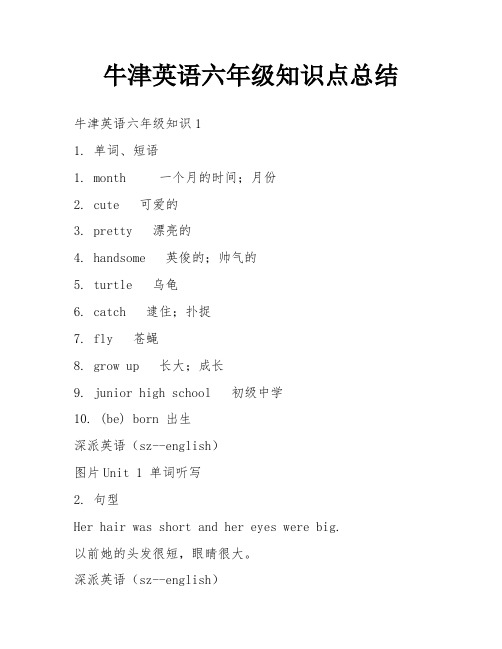
牛津英语六年级知识点总结牛津英语六年级知识11. 单词、短语1. month 一个月的时间;月份2. cute 可爱的3. pretty 漂亮的4. handsome 英俊的;帅气的5. turtle 乌龟6. catch 逮住;扑捉7. fly 苍蝇8. grow up 长大;成长9. junior high school 初级中学10. (be) born 出生深派英语(sz--english)图片Unit 1 单词听写2. 句型Her hair was short and her eyes were big.以前她的头发很短,眼睛很大。
深派英语(sz--english)图片Unit 1 Lisen and say 听写图片Unit 1 Read a story 听写3. 重难点1.一般过去时表示过去某个时间里发生的动作,常和表示过去的时间状语连用,如:yesterday,last night,this morning,in 1990,ago,since 1999,last(week,year,night,month...)等。
2.过去式顺口溜动词一般过去时,表示过去发生的事;一般动词加ed,若是特殊得硬记;be 用was 或用were,have,has变had;谓语动词过去式,过去时间做标志;否定句很简单,主语之后didn't添;疑问句也不难,did放在主语前。
牛津英语六年级知识21. 单词、短语1. famous 著名的;出名的2. during 在......期间3. spend 度过4. everyone 每个人;所有人5. countryside 乡村;农村6. pick 采摘7. summer holiday 暑假深派英语(sz--english)图片Unit 2 单词听写2. 句型1. How was your summer holiday?你的暑假过得怎样?2. It was wonderful!We went to the Great Wall.非常棒!我们去了长城。
人教版六年级上册英语知识点汇总
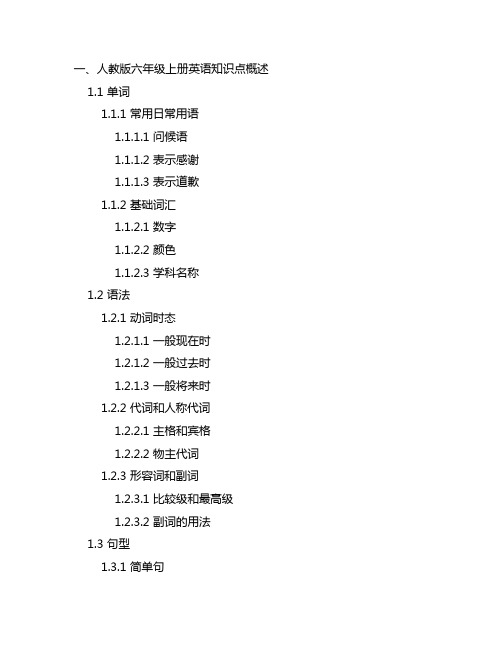
一、人教版六年级上册英语知识点概述1.1 单词1.1.1 常用日常用语1.1.1.1 问候语1.1.1.2 表示感谢1.1.1.3 表示道歉1.1.2 基础词汇1.1.2.1 数字1.1.2.2 颜色1.1.2.3 学科名称1.2 语法1.2.1 动词时态1.2.1.1 一般现在时1.2.1.2 一般过去时1.2.1.3 一般将来时1.2.2 代词和人称代词1.2.2.1 主格和宾格1.2.2.2 物主代词1.2.3 形容词和副词1.2.3.1 比较级和最高级1.2.3.2 副词的用法1.3 句型1.3.1 简单句1.3.1.1 肯定句1.3.1.2 否定句1.3.1.3 疑问句1.3.2 复合句1.3.2.1 并列句1.3.2.2 定语从句1.3.2.3 状语从句二、人教版六年级上册英语知识点详解2.1 单词2.1.1 常用日常用语2.1.1.1 问候语问候语是指在英语日常交际中用于打招呼和示好的常用词汇,包括Hello、Hi、Good morning、Good afternoon等等。
2.1.1.2 表示感谢表示感谢的常用词汇有Thank you、Thanks a lot、Thank you very much等,用于表达对别人的帮助或礼物表示感激之情。
2.1.1.3 表示道歉表示道歉的词汇包括I'm sorry、Excuse me、Pardon等,在日常生活中,用于向别人道歉或请求对方让步的场合。
2.1.2 基础词汇2.1.2.1 数字数字是英语基础词汇的重要部分,包括基本的数字表达方式和计量单位,如one、two、three等,以及hundred、thousand等。
2.1.2.2 颜色颜色是描述事物外观的重要词汇,在日常交流中也经常用到,包括red、blue、yellow等常见颜色词汇。
2.1.2.3 学科名称学科名称涉及到人们日常生活和学习工作的方方面面,包括mathematics、music、art等,是学习英语时必须掌握的词汇。
最新完整版人教版六年级英语上册第二单元知识点归纳总结及作文范文
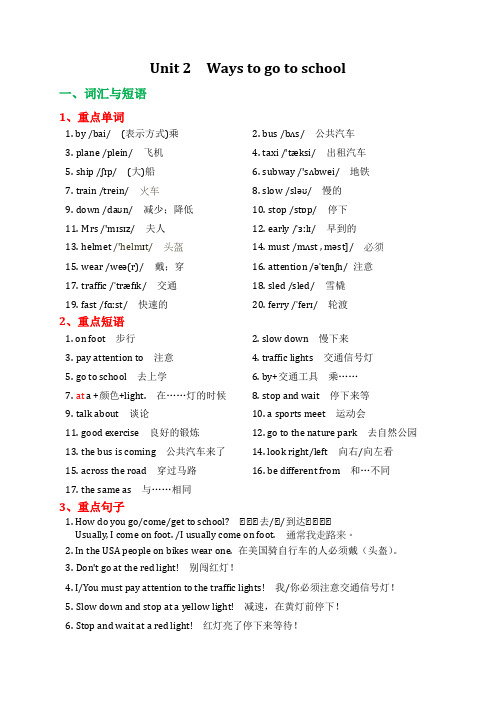
Unit 2 Ways to go to school一、词汇与短语1、重点单词1. by /bai/ (表示方式)乘2.bus /bʌs/ 公共汽车3.plane /plein/ 飞机4.taxi /'tæksi/ 出租汽车5.ship /ʃɪp/ (大)船6.subway /'sʌbwei/ 地铁7.train /trein/ 火车8.slow /sləʊ/ 慢的9.down /daʊn/ 减少;降低10.stop /stɒp/ 停下11.Mrs /'mɪsɪz/ 夫人12.early /ˈɜːlɪ/ 早到的13.helmet /'helmɪt/ 头盔14.must /mʌst , məst]/ 必须15.wear /weə(r)/ 戴;穿16.attention /əˈtenʃn/ 注意17.traffic /ˈtræfɪk/ 交通18.sled /sled/ 雪橇19.fast /fɑːst/ 快速的20.ferry /ˈferɪ/ 轮渡2、重点短语1. on foot 步行2.slow down 慢下来3.pay attention to 注意4.traffic lights 交通信号灯5.go to school 去上学6.by+交通工具乘……7.at a +颜色+light. 在……灯的时候8.stop and wait 停下来等9.talk about 谈论10.a sports meet 运动会11.good exercise 良好的锻炼12.go to the nature park 去自然公园13.the bus is coming 公共汽车来了14.look right/left 向右/向左看15.across the road 穿过马路16.be different from 和…不同17.the same as 与……相同3、重点句子1. How do you go/come/get to school? 你你你去/你/到达你你你你Usually, I come on foot. /I usually come on foot. 通常我走路来。
人教精通版小学六年级英语下册期末考试知识总结

人教精通版小学六年级英语下册期末考试
知识总结
本文档对人教精通版小学六年级英语下册期末考试知识进行总结,旨在帮助学生复和备考。
1. 词汇与拼写
本节主要总结下册中重要的单词和拼写规则。
- 研究新单词的正确拼写。
- 复已学单词的拼写和词义。
2. 语法
本节主要总结下册中涉及的语法知识点。
- 时态:一般现在时、一般过去时和一般将来时。
- 句型结构:陈述句、疑问句和否定句。
- 代词:人称代词、物主代词、指示代词等。
- 数量词:用于表示数量的词语。
3. 阅读理解
本节主要总结下册中的阅读理解部分。
- 阅读短文,理解短文内容。
- 回答与短文相关的问题。
- 根据短文填写信息或选择正确的答案。
4. 口语与写作
本节主要总结下册中涉及的口语和写作知识。
- 口头表达能力:运用已学的句型和单词进行口头表达。
- 书面表达能力:根据题目要求写出一篇对话或短文。
5. 音标与发音
本节主要总结下册中的音标和常见的发音规则。
- 掌握音标的发音和书写。
- 根据单词的发音规则正确读音。
6. 其他技能
本节主要总结下册中的其他技能。
- 听力技巧:听懂对话和短文,回答相应问题。
- 句子翻译:将中文句子翻译成英文,或将英文句子翻译成中文。
希望以上总结能够帮助学生顺利备考并取得好成绩。
祝大家考试顺利!。
人教版人教版小学英语六年级上册知识点归纳图文稿
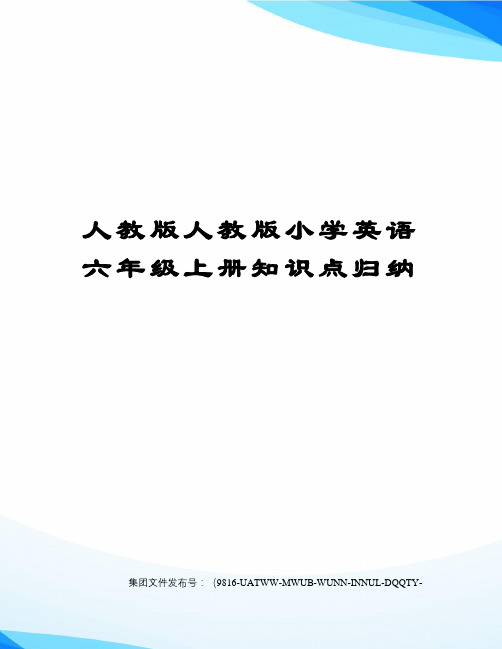
人教版人教版小学英语六年级上册知识点归纳集团文件发布号:(9816-UATWW-MWUB-WUNN-INNUL-DQQTY-人教版(PEP)小学英语总复习六年级上册知识点Unit1Howcan I get there一、主要单词:museum博物馆 bookstore书店 cinema电影院 turn 转弯 hospital医院 left向左 post office 邮局 science科学right向右straight笔直地 crossing十字路口二、习惯语搭配:post office邮局 science museum科学博物馆 pet hospital宠物医院Italian restaurant意大利餐馆 Beihai Park北海公园 Palace Museum 故宫博物院 go straight直走 turn right/left右/左转 next to挨着in front of...在...前面 near the park在公园附近 on Dongfang Street在东方大街上三、惯用表达式:Excuse me 打扰一下 Follow me, please!请跟着我!四、公式化句型:1、问路的句型及其答语:问句:Where is the + 地点?···在哪儿?答语:It’s + 表示地点的词语。
它···。
2、询问怎么到某地的句型及其答语:问句:How can +主语 + get (to)+地点···怎么到···同义句型:Can you tell me the way to +地点Where is + 地点Which isthe way to +地点答语:Turn +方向+表示地点的介词短语。
···转。
五、例句:Whereisthecinema,please请问电影院在哪里?It’snexttothehospital. 它与医院相邻。
六年级上册英语1-4单元必考知识点总结

Unit 3 What are you going to do?
一.词汇 'next week 下周
newsp叩er 报纸
this morning 今天上午
comic book漫画书
Time: (时间)
this afternoon 今天下午 this evening今天晚上
magazine 杂志 dictionary 字典
make kites (making kites )制作风筝 colLect stamps (collecting stamps)集邮
三单
Live (lives)居住,住 teach (teaches)教 go (goes)去 watch (watches)看 read (reads)读
其他show (展览)
(交通工具前加by,表示乘坐但步行要用on foot)
三会一
fifth第五 difference 不同 country 国家 right右边的 Australia澳大利亚 if如果
remember 记住 same相同的 mean意思是
side 边 however 但是 must必须
find找到 every每个所有的 drive驾驶
do (does) pen pal(笔友)
dear (亲爱的)
look(看上去)fun(快乐,乐趣)
with(同…)
三、重点句型:
1 .询问某人的爱好:
---------- What's your hobby?你的爱好是什么?
-----------1 Like collecting stamps.我喜欢集邮 2 .表示征求别人意见:
我坐飞机去。
■ ----------- How does your father go to work? ----------- He goes to work by subway.
译林版六年级上册英语期末考试常考知识点及题型总结

译林版六年级上册英语期末考试常考知识点及题型总结常考单词:long long ago很久以前clever聪明的foolish 愚蠢的turn into 变成through 穿过laugh 大笑wear 穿,戴tell 告诉quick 迅速的,快的each 每个sentence 句子say 说little 小的,年幼的next 下一个turn 机会think 想,思考hard 努力地,费劲地child 孩子(复数children)magic有魔力的,神奇的sunny 晴朗的show 展示interesting 有趣weather 天气become 变成,变为windy 有风的cloudy 多云的high在高处sky天空bring 带来honey 蜂蜜drink 饮料rain 下雨,雨水(不可数名词)ant 蚂蚁bee 蜜蜂cloud 云meet 遇到lose 丢失know 知道What happened? 出了什么事?climb up 爬上hold onto 抓紧fly away 飞走rainy 多雨的,有雨的holiday 假日,假期National Day 国庆节call 打电话bund (上海)外滩Shanghai Museum 上海博物馆star 星星Great Wall 长城Palace Museum 故宫ask 问Summer Palace 颐和园Tian’anmen Square 天安门广场bottle 瓶子fashion show 时装表演excited 激动的,兴奋的paper 纸go well 进展顺利at first 开始,最初heavy rain 大雨then and now 过去和现在ago …以前yesterday 昨天use 使用,利用telephone 电话office办公室mobile phone 移动电话,手机anywhere 随处,到处radio 收音机newspaper 报纸news 新闻watch 观看e-book 电子书look out of 朝……外看TV 电视go on 继续What day is it today? still 仍然spell 拼读,拼写make a sentence 造句with 用语法:一.一般过去时(一)时态含义:表示过去某个时间发生的动作(二)时态标志:yesterday昨天, last week/year…上周/去年…(last上一个),just now刚才,this morning/ afternoon,…ago 等四种时间状语①yesterday及相关短语。
六年级英语必背知识点归纳
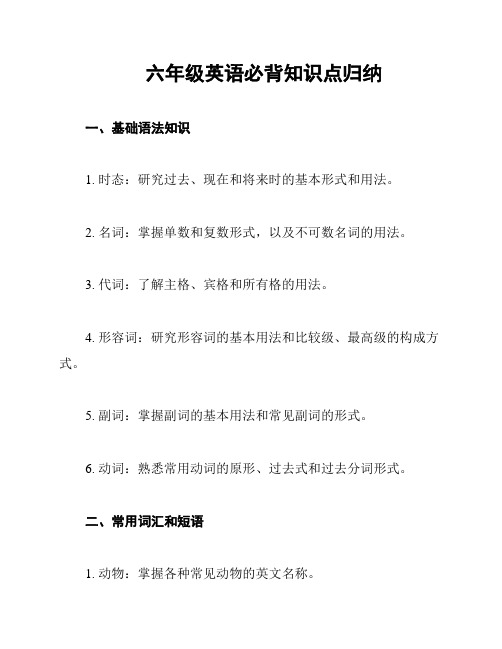
六年级英语必背知识点归纳一、基础语法知识1. 时态:研究过去、现在和将来时的基本形式和用法。
2. 名词:掌握单数和复数形式,以及不可数名词的用法。
3. 代词:了解主格、宾格和所有格的用法。
4. 形容词:研究形容词的基本用法和比较级、最高级的构成方式。
5. 副词:掌握副词的基本用法和常见副词的形式。
6. 动词:熟悉常用动词的原形、过去式和过去分词形式。
二、常用词汇和短语1. 动物:掌握各种常见动物的英文名称。
2. 食物:熟悉各种常见食物的英文名称。
3. 学校:了解学校里的各种地点和设施的英文表达。
4. 家庭:掌握家庭成员的英文称呼和家庭常用词汇。
5. 交通工具:熟悉常见交通工具的英文名称。
三、日常用语和常见句型1. 问候与介绍:掌握日常问候和自我介绍的常用表达。
2. 时间和日期:学会表达时间和日期的基本句型。
3. 祝福与道别:了解常见的祝福和道别用语。
4. 请求和应答:掌握常用的请求和应答句型。
5. 询问和回答:学会询问问题和回答问题的常用句型。
四、阅读理解1. 短文理解:通过阅读短文,理解其中的主要内容和细节。
2. 选择题理解:学会根据问题选择正确的答案。
3. 完形填空:通过选择正确的词语,填充短文中的空白部分。
4. 阅读技巧:掌握一些阅读理解的技巧和方法。
五、口语表达和听力理解1. 日常对话:通过模仿和练,掌握日常对话中的基本表达方式。
2. 听力训练:通过听力练,提高对英语的听力理解能力。
3. 总结归纳:将所学的知识点进行总结归纳,加深记忆。
以上是六年级英语必背知识点的主要内容归纳,希望能对你的研究有所帮助。
(优质)六年级英语知识点整理PPT课件

(三)一般将来时
1.概念:表示将要发生的动作或存在的状态及打算、 计划或准备做某事。句中一般有以下时间状语: tomorrow, next day(week, month, year…),soon, the day after tomorrow后天等
are. 例子:She is a teacher. They are teachers. You are a
student. I am a teacher. 3.have , has 的选择: 表示某人有某物。单数用has , 复数用have. I ,you 用 have .
例子:I have a pen. She has a pen. They have many pens.
③ 以辅音字母加y结尾的动词要改y为i再加ed(此类动 词较少)如 study – studied ,carry – carried ,worry – worried (注意play、stay不是辅音字母加y,所以不 属于此类)
④ 双写最后一个字母(此类动词较少)如 stop -stopped plan--planned
2.不规则动词(此类词并无规则,须熟记 )小学阶段要记住以下动词的原形和过去 式:sing – sang , eat – ate , see – saw , have – had , do – did , go – went , take – took , buy – bought , get – got , read – read ,fly – flew , am/is – was , are – were , say – said , make – made , swim – swam , tell – told , come – came , think-thought, drink – drank , hurt – hurt , feel – felt , put – put , fallfell.
六年级英语考试总结图文稿

六年级英语考试总结集团文件版本号:(M928-T898-M248-WU2669-I2896-DQ586-M1988)六年级英语期末考试总结与反思在散学典礼仪式中,在期末总结大会上,第一学期教学工作告一段落了。
回顾这一年来的工作,有喜有忧,有得有失。
本学年担任本校的六年级英语教学工作,在过去的几个月确实在摸黑之中度过,但经过一年的教学,有进步的地方,也有不足之处,现在总结如下:由于学生的基础不大好,接受能力差,英语考试难度又大,使学生在英语教学遇到更多难以解决的实际问题,因此考试成绩并非理想。
针对各班级的不同特点,我积极试着采取不同的教学方法。
但基本上都是按照英语教学常规,让学生多听、多读、多练,从练习中不断提高能力。
因此,在英语教学中我需要朝着以下的新方向努力:首先培养学生的“兴趣”,爱因斯坦曾这样说“‘兴趣’是最好的老师”。
学生对于自己感兴趣的事物,自然会用更多的时间钻研。
因此,在教学中要尽量使用英语,适当利用母语;利用直观教具、动作、表情和玩游戏等方法吸引学生,让学生乐于学习。
而且,教学中必须做到让学生明白,会用,反复练习句型和单词,提高水平,进行生动活泼的开放式的课堂教学,使学生从愉快的情景中学到,从而提高学生对英语科的学习兴趣,提高了教学效果。
所以在课堂教学中要特别注意学生的兴趣的培养。
在课堂上,我首先让学生明白每课的句型结构,懂得它的规律,学会用学过的单词使用新句型对话。
对话中照顾不同发展程度的学生,做到难易得当,让每个学生都有练习的机会,增强学生学习的信心,提高对话的反应能力。
每课讲授完后,要求学生必须读熟,会默写单词,会做基本的对话练习。
英语的学习是狠抓句型及单词,因此,每天早上要求学生抽出一定时间开口读英语,锻炼口语能力,熟悉课文。
在班级选出读音规范的科代表,由教师指导培养好科代表。
而且教师经常巡视和抽测,使学生不知不觉巩固所学习的单词;要求每节课前学生听写十个单词,必须做到完全正确。
pep六年级英语上下册知识点总结(K12教育文档)

pep六年级英语上下册知识点总结(word版可编辑修改)编辑整理:尊敬的读者朋友们:这里是精品文档编辑中心,本文档内容是由我和我的同事精心编辑整理后发布的,发布之前我们对文中内容进行仔细校对,但是难免会有疏漏的地方,但是任然希望(pep六年级英语上下册知识点总结(word版可编辑修改))的内容能够给您的工作和学习带来便利。
同时也真诚的希望收到您的建议和反馈,这将是我们进步的源泉,前进的动力。
本文可编辑可修改,如果觉得对您有帮助请收藏以便随时查阅,最后祝您生活愉快业绩进步,以下为pep六年级英语上下册知识点总结(word版可编辑修改)的全部内容。
六年级上册英语知识点总结Unit 1 How can I get there?一:重点单词和短语Science科学, museum博物馆, post office, bookstore, cinema,hospital ,tasty, buy, London Eye伦敦银, stomach胃,crossing十字路口, turn left, turn right,go straight=walk straight直走。
next to紧挨着/与。
相邻, far from (离.。
远),near在。
附近,behind(在。
.后面), in front of(在.。
前面) , between…and…(在。
和。
.。
之间)二:按要求写单词:hot(反义词)cold , cool(反义词)warm, too(同音词)to/two can not(缩写)can’t right(反义词)left/wrong buy(同音词)by/bye sea(同音词)see first(基数词)one four(序数词)fourth did (原形)do/does three(序数词)third give(过去式)gave三:重点句型分析1. Where is the museum shop?此问句是由特殊疑问词where 引导的一个特殊疑问句, where意为“在哪里,到哪里”,用来询问地点,放在句子的开头。
小学六年级总复习知识归类[英语]
![小学六年级总复习知识归类[英语]](https://img.taocdn.com/s3/m/7e8b10a10b4e767f5bcfce7b.png)
FUN WITH ENGLISH小学六年级总复习知识归类1、字母(1)字母:(大小写)辨认、书写顺序:Aa Bb Cc Dd Ee Ff Gg Hh Ii Jj Kk Ll Mm Nn Oo Pp Qq Rr Ss Tt Uu Vv Ww Xx Yy Zz.(2)元音字母:A a , Ee, Ii, Oo, Uu字母音素表:Aa Hh Jj KkEe Bb Cc Dd Gg Pp Tt VvIi YyOoUu Qq WwFf Ll Mm Nn Ss Xx ZzRr(3)书写容易错误的字母:E , F , G, M, N, d, i, p, q, x, y.(4)字母代表的专有名词:BBC, NBA, UN, UK,ABC,USA, am, pm, kg, cm, 等。
2、数字:基数词和序数词的运用,如计算、购物、询问时间等.基数词: One, two, three, five, six, seven, eight, nine, ten , eleven, twelve, thirteen, fourteen, fifteen… twenty, twenty-one… thirty, forty, fifty… eighty, ninety, one/a hundred , one/a hundred and one… two hundred.序数词: first , second , third , fourth , fifth, sixth, seventh, eighth, ni nth, tenth, eleventh, twelfth… twentieth, twenty-first, twenty-second, twenty-third, twenty-four…thirtieth, fortieth, fiftieth… eightieth, ninetieth…相关句型:1) What’s thirty plus forty? It’s seventy.2) What’s your telephone number? My telephone number is 83555723.3) What time is it ? It’s half past ten.What’s the time? It’s ten thirty.4) When do you usually get up ? At six thirty-five.5) How old are you? I’m twelve.6) How much is it / are they ? It ‘s / They’re 50 yuan.7) How many cars do you have ? I have 6 cars.8) How many birds can you see in the tree? I can see 3.9) How many dolls are there on the bed? There is one/a doll.10) How many dolls are there on the bed? There are four dolls.11) Which floor do you live on? I live on the fifth floor.12) Excuse me, can you tell me the way to the History Museum?Yes, go down this street, then turn left at the third crossing….13) Who’s the fifth girl from the right? She’s my cousin.14)When’s your birthday? It’s on the ninth of April.注意:数词的应用;不可数名词及它的量的表示方法;many与much在用法上的区别;some 和any在用法上的区别;there is/are与have/has在用法上的区别.3、颜色:实物的颜色colours: red, yellow, brown, blue, orange, black, white, grey, (pink) (purple) (golden) (dark blue) (light blue).相关句型:1) What colour is your coat? It’s ...Wh at colour are…? They’re…2) What’s your favourite colour? My favourite colour is …3)What colour do you like best?4、时间:年、季节、月、星期、日、时刻year, season( spring, summer, autumn, winter) ,month: January, February, March, April, May, June, July, August, September,October, November, December.Week: Sunday, Monday, Tuesday, Wednesday, Thursday, Friday, Saturday.Day: 1st May (the first of May), May 2nd ( May the second)Time: (an) hour, minute, second10:05 (five past ten, ten o five)10:10 (ten past ten, ten ten)10:15 (a quarter past ten, ten fifteen)10:30 (half past ten, ten thirty)10:45 (a quarter to eleven, ten forty-five)11:00 (eleven o’clock)相关句型:1) How old is your mother? She’s thirty-six years old.2) How many months are there in a year? There are 12.3) When’s your birthday? My birthday is on 15th January ( the fifteenth of January).4) When do you get up? I get up at six o’clock.5) When’s spring in China? It’s in March, April and May.When does spring last? It lasts for 3 months from March to May.6)What time is it? It’s a quarter to nine.5、食品、饮料、水果:人对食品、饮料和水果的喜好;东西方食品food : meat, rice, fish, bread, egg, hamburger, biscuit, sandwich, pie, noodles, dumpling, mooncake, ice-cream, hot dog…d rinks : water, milk ,orange juice , coffee, tea, soft drinks …fruits: apple, orange, banana, grape, pineapple, mango, lemon, watermelon,peach, strawberry相关句型:1) Would you like something to drink/eat? Yes, I’d like some…No, thanks .2) Would you like t o eat/drink…? I’d like to eat/drink…No, thanks .3) What’s your favourite food/drink/fruit? My favourite food/drink/fruit is …4) Could I have some…? Yes, please .6、服装:服装的颜色:人对服装的喜好;某人的穿戴;所属关系clothes: hat, cap, coat, shirt , T-shirt, skirt, dress, sweater, jacket, trousers, socks, shoe,jeans, shorts,blouse, tie, costume,belt, gloves, scarfput on(wear) / take off所属关系: 形容词性的物主代词:my, your, his, her, its, our, your, their名词性的物主代词: mine, yours, his, hers, its, ours, yours,theirs相关句型:1) Whose shoes are these? They’re mine. They’re Tom’s .2) Is this /that/it your book? Yes, it is. No, it isn’t.3) Is this pencil yours? Yes, it is. No, it isn’t.4) Are these /those/they your coats and trousers? Yes, they are. No, they aren’t.5) Are those clothes theirs? Yes, they are. No, they aren’t.6) This is my hat. That hat is his.注意:名词单,复数;物主代词(名词性的物主代词,形容词性的物主代词);名词所有格,如:Tom’s , my father’s , the teachers’.7、玩具和文具:特点、颜色、所属关系;存在的位置Toys: doll, toy, puppet, puzzle, balloon, mask , yo-yo, kite…文具: desk, book, bag ,pen, pencil, pencil-box, ruler, chair, ball,rubber, sharpener,stapler, crayon, copybook, bookmark, notebook, ….存在的位置: in, on, under, beside, behind, in front of, at the back of , in the front of , in the middle of, between, in the center of …).相关句型:1) There is a cup of tea on the table.2) There are some oranges in the fridge.3) Is there any milk in the glass? Yes, there is. No, there isn’t.4) Are there any oranges in the fridge? Yes, there are. No, there aren’t.5) What’s under the desk? There is an orange . / There are some oranges.8、日常生活用品:特点、颜色、形状、所属关系;存在的位置words: table, clock, brush, telephone, light, computer, fridge, glass, knife,bottle, box, plate, photo, fax, radio, purse, fan, tape, cup, watch, bookcase,bed, fork, basket, umbrella, TV, spoon, cupboard, bowl, telephone, sofa, lamp…特点: big, small, heavy, light, white, black, old, new, beautiful, cute, tall, short, strong, nice, good, bad, lovely…形状:shape ,star, rectangle, diamond ,triangle ,square ,circle相关句型:1)This is a new table. / This table is new.2)That’s a nice telephone. / That telephone is new .3) These are forks . Those are spoons .4) What shape is the table ? It’s an oval /a rectangle /square …9、动物:家畜、家禽;农场动物、动物园及野生动物的特点;生活地点和所属关系words(animals): cat, dog, duck, fish, sheep, bird, panda, monkey, rabbit, chick, tiger, lion, pig,cow , mouse (mice), bear, elephant, grasshopper, ant, butterfly…生活地点:at home, on a farm, in /at a zoo …相关句型:What animal do you like best ?描述动物特点10、植物:特点、所属关系;存在的位置words: tree, grass,flower, leaf (leaves) …11、环境与建筑:特点、所属关系;存在的位置buildings: hospital, park, house, library, museum, office, farm, post office, bank,police station, train station, airport, shop center, supermarket, theatre, snackbar,restaurant, countryside, school, classroom, computer room, toilet, musicroom, house: bathroom, living-room, sitting-room, bedroom, kitchen, garden…房子的基本构造:door, gate, wall, window, floor…相关句型:1) Where do you study at/ in ? I study at Nan Changjie Primary School.2) Where does your mother work at/ in ? She works at a hospital.3) Let’s meet at the gate of the park.4) My brother is playing in the garden.12、身体:特点body: head, hair, eye, nose, ear, mouth, neck, shoulder, hand, finger,foot(feet) ,toe…外貌: fat, thin, tall, short, strong, beautiful, nice, old, young, round face, two big blue eyes, long hair, short hair, black hair ,white hair…形容词比较级相关句型:1) I’m /You’re /He’s/She’s /We’re /They’re (not) tall.2) Is he/she tall or short? He’s /She’s tall (short).3) I’m taller than…/ I’m as old as…/ My hair is longer than…/4) I/We/They/You have (got) black hair.5) He/She has ( got ) a round face.6) Does he/ she have…?Yes, he/she does. No, he/she doesn’t.7)Has he/she got long hair ? Yes, he/she has.No, he/she hasn’t.注意:描述人的外貌时,have与has用法上的区别;形容原级和比较级词的用法,如:tall, short, old, young, black , long…13、个人情况:姓名、年龄、地址、特点与爱好age, year, address, e-mail address, hobby,hobby: collecting stamps(coins) , going swimming…doing sth.副词原级和比较级的用法相关句型:1) How old are you ? I’m thirteen years old.2) I’m a thirteen-year old boy.3) What’s your address? I live at No.48 Renmin Road.4) What’s your e-mail address? My e-mail address is 123VIP@.5) What’s your hobby? My hobby is going running. Or : I like going running.6) I /You/ They like music.7) He likes traveling.8) Do you like reading? Yes, I do. No, I don’t.9) Does he /she like playing basketball? Yes, he/she does. No, he/she doesn’t.10)Does he jump high? Yes. Does he jump higher than…注意:描述个人的喜好时:名词和动词- ing 形式作宾语;主语是第三人称单数时一般现在时动词的变化。
小学六年级英语必考知识点小结
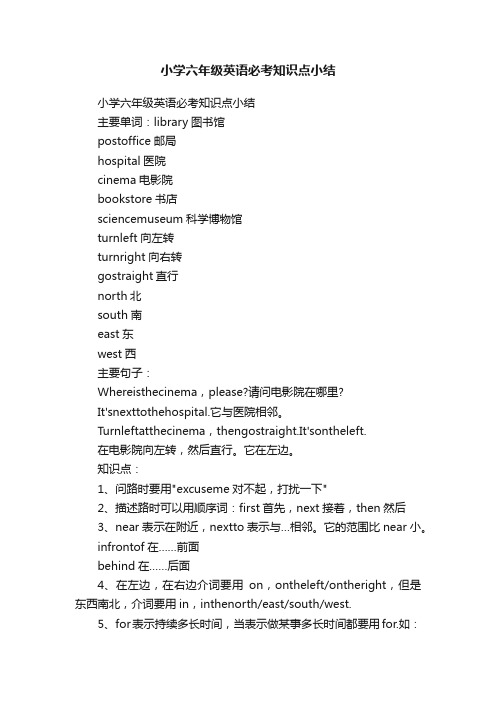
小学六年级英语必考知识点小结小学六年级英语必考知识点小结主要单词:library图书馆postoffice邮局hospital医院cinema电影院bookstore书店sciencemuseum科学博物馆turnleft向左转turnright向右转gostraight直行north北south南east东west西主要句子:Whereisthecinema,please?请问电影院在哪里?It'snexttothehospital.它与医院相邻。
Turnleftatthecinema,thengostraight.It'sontheleft.在电影院向左转,然后直行。
它在左边。
知识点:1、问路时要用"excuseme对不起,打扰一下"2、描述路时可以用顺序词:first首先,next接着,then然后3、near表示在附近,nextto表示与…相邻。
它的范围比near小。
infrontof在……前面behind在……后面4、在左边,在右边介词要用on,ontheleft/ontheright,但是东西南北,介词要用in,inthenorth/east/south/west.5、for表示持续多长时间,当表示做某事多长时间都要用for.如:Walkeastfor5minutes?Thenwalkstraightforthreeminutes.6、乘几路车可以用bytheNo.301bus,注意No.中N要大写,后面要加点。
如果要用动词可以用take,例如taketheNo.301bus.7、当表示某个地方在另一个地方的哪一方向时,要用介词of。
如:thehospitaliseastofthecinema.医院在电影院的东边。
8、表示在哪儿转时,用介词at。
如:Turnleftatthebank。
在银行左转。
9、find表示"找到",强调找的结果。
- 1、下载文档前请自行甄别文档内容的完整性,平台不提供额外的编辑、内容补充、找答案等附加服务。
- 2、"仅部分预览"的文档,不可在线预览部分如存在完整性等问题,可反馈申请退款(可完整预览的文档不适用该条件!)。
- 3、如文档侵犯您的权益,请联系客服反馈,我们会尽快为您处理(人工客服工作时间:9:00-18:30)。
六年级英语考试常见知
识点总结
集团文件版本号:(M928-T898-M248-WU2669-I2896-DQ586-M1988)
英语1.表示时间的介词
(1)at:用于表示时刻,时间的某一点。
at noon在午时 at night在夜间 at present目前(2)on:用于星期,某天,某一天的上午、下午、晚上(指具体的某一天时,一律用on)
on Sunday在星期天 on sunday morning 在星期天的上午
on march 8 在3月8日
(3)in:用于表示周、月、季节、年、泛指上午、下午、晚上。
in 1999 在1999年 in November 在11月份
in summer 在夏季 in the afternoon在下午
at表示片刻时间;in表示一段时间;on总是与日子有关。
2.表示地点的介词
(1) at:在某地点(表示比较狭窄的场所)
at school上学 at home在家 at the station 在火车站
(2)in:在某地(表示比较宽敞的场所)
she will arrive in shanghai at ten .10点她将到达上海。
3.时态:
(1)一般过去时是指发生在过去的事;如句子中有yesterday, last week , last weekend , last yesterday , last Sunday 等这样表示过去时间的词时,就要用一般过去时态。
如果be动词是was、were,或者动词加ed都表示是一般过去时。
(2) 现在进行时是指正在发生的事;句中往往有now、look、listen等词。
现在分词就是动词ing 共有三种形式: ①直接 + ing ②去e + ing
③双写最后一个字母 +ing
(3)一般现在时是指经常发生的事。
句式:主语 + 动词原型或动词变形(动词第三人称变化)+ 其它成分
(4)一般将来时指将要发生的事和打算做的事。
典型单词有: tomorrow ;the day after tomorrow;tomorrow morning
构成形式:Be going to +动词原形,will +动词原形
4.时间和日期的表达:
时间点:
(1)直接读写数词:如8:30 eight thirty
(2)借助past和to来表达:past一般用于30分钟以内(含30分钟)的时间表达;to一般用于超过30分钟的时间表达。
一刻钟可以用a quarter表示,半小时可以用half表示。
①6:45 six forty-five 或者 a quarter to seven
②9:05 nine o five 或者five past nine
③3:22 three twenty-two 或者 twenty-two past three
④5:50 five fifty 或者 ten to six
⑤8:30 eight thirty 或者 half past eight
日期:
⑴星期
例句:① What day is today
Today is Tuesday. 今天星期几?今天星期二。
②I?ve never worked on Sundays. 我从未在星期日工作过。
注:在星期几表示具体某一天用介词on,但是如果有next,this,that, last等词修饰时不加介词on
⑴年 +月:与在某个月份相同,介词用in
例句:He went to Nanjing in June, 2000. 他在2000年6月去了南京
⑵年+月+日:在具体的某年某月某号,也就是在具体的某一天用介词on 例句: They married on December 18th,2010. 他们在2010年12月18日结婚
5.方位介词:in, on, under, behind, near..….
1). in表示"在……中", "在……里面"。
例如in our class 在我们班上 in my bag 在我的书包里in the classroom 在教室里
2). on 表示"在……上"、"在……表面"。
例如 on the wall 在墙上 on the desk 在桌子上 on the blackboard 在黑板上3). under表示"在……下"。
例如 under the tree 在树下 under the chair 在椅子下 under the bed 在床下
4). behind表示"在……后面"。
例如 behind the door 在门后 behind the tree 在树后
5). near表示"在……附近"。
例如 near the teacher's desk 在讲桌附近 near the bed 在床附近6). beside表示"在……旁边"。
(比near近)
例如 beside the table 在书桌旁边 beside the river在河边
7)in front of表示“在……前面”。
例如 in front of the library在图书馆前面 in front of the restaurant在餐厅前面
8)across from表示“在……对面”
例如 across from the park 在公园对面 across from the bank 在银行对面
6.一些基础句式:
①sb like(s) doing sth/to do sth 某人喜欢某事
②sb can do sth 某人能做某事; 【情态动词 can、must、should、would、may。
情态动词后动词总是用原形。
(不受其他任何条件影响)】
③sb don't/doesn't need to do sth 某人不用做某事
④It's time to do sth 该是(做)的时候了
7.冠词a、an、the:
a和an的区别:an用于元音音素(一般就是元音字母aeiou)前,a用于辅音音素前。
the用于特指。
例如:an orange 一只桔子 a cat一只猫 the earth这个地球
8. there be句型与have(has) 的区别:
there be 表示在某地有某物(或人);have(has) 表示某人拥有某物。
在there be 句型中,主语是单数,be 动词用is ; 主语是复数,be 动词用are ; 如有几件物品,be 动词根据最靠近be 动词的那个名词决定。
9. 常用疑问词:
①When什么时间;问时间②What time 什么时间问具体时间,如几点钟③Who谁;问人④Whose 谁的问主人⑤Where在哪里;问地点⑥Which哪一个;问选择⑦Why 为什么;问原因⑧What问什么东西、事物⑨What colour什么颜色;问颜色⑩What about。
怎么样;问意见 What day星期几;问星期 What date什么日期;问日期
How 。
怎样问情况 How old多大年纪问年纪
How many多少数量(可数名词)问数量
How much多少钱;多少数量(不可数名词)问多少钱或数量(不可数)How about。
怎么样;问意见 How often多久问频率
How long多长时间;问时间长度 How far 多远;问多远、多长距离
“完形填空/首字母填空”做题技巧
1.跳开空格、通读全文、把握文章大意
一般此题型的文章主要以记叙文或者议论文为主,所以在下笔做题前,应对每篇文章的大意有所了解,把握文章大意,不要仓促下笔。
2.重视主题句
这种题型所用的短文一般不给标题,但短文的主题句,往往在每段文章的首句,有时也出现在文章的中间或结束处。
主题句是深入了解全文的“窗口”,因为它往往概括了每段的大意,为我们做题提供了很好的线索。
3. 语境联想、瞻前顾后、先易后难
每个空格涉及的题型千变万化,主要以考察固定搭配、近义词辨析、时态、语态、介词、连词等为主,因此必须联系上文,逐个击破。
容易题先做,不能马上确定答案的切勿思考过久,可先跳过,等全文基本做完,加深理解后再来思考。
3.复读全文,逐一检查
对于完型填空,完成各道题选择后,把所选的答案代入原文,再把全文通读一篇,看所选定的答案是否使短文意思前后连贯、顺理成章,语法结构是否正确,是否符合习惯表达法。
对于首字母填空,检查每个空格的重点则应放在所填动词的时态及语态、名词单复数、第三人称单数上,避免失掉本应到手的分数。
